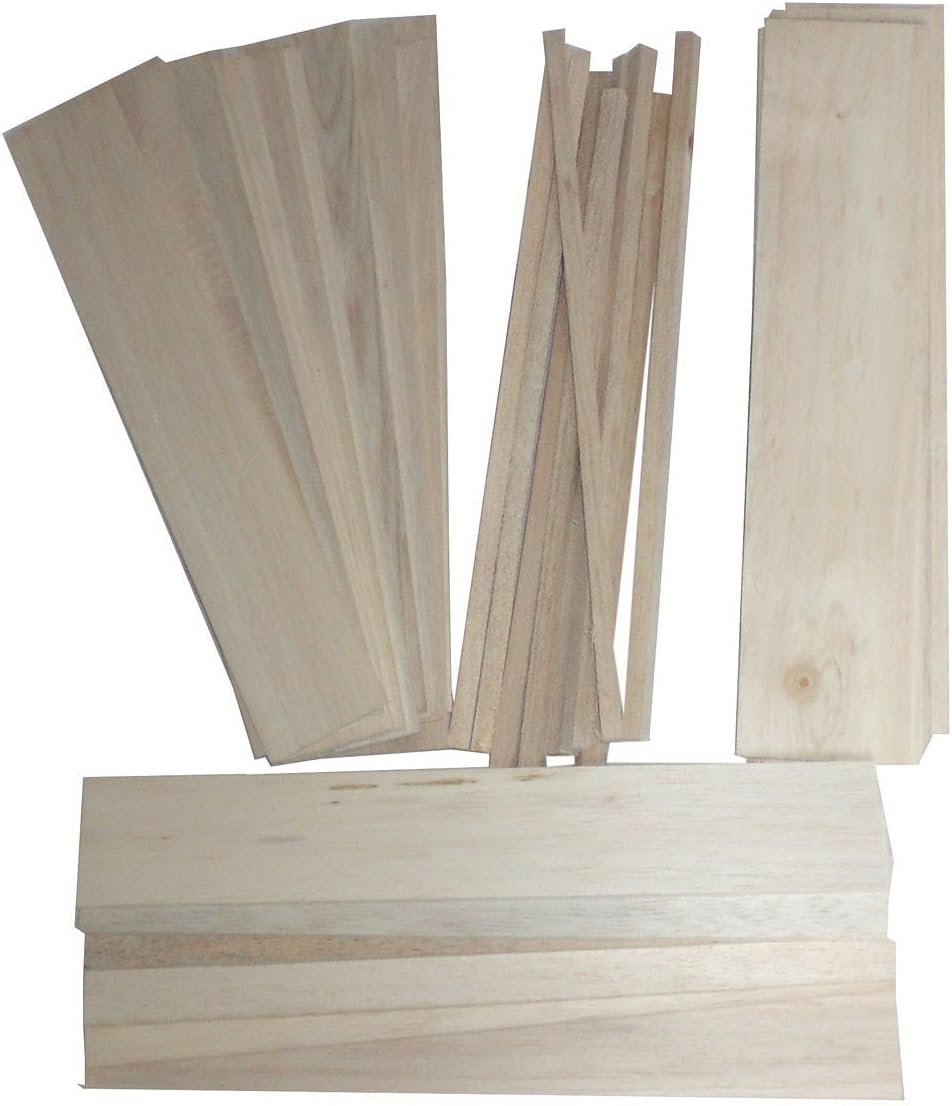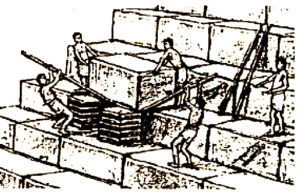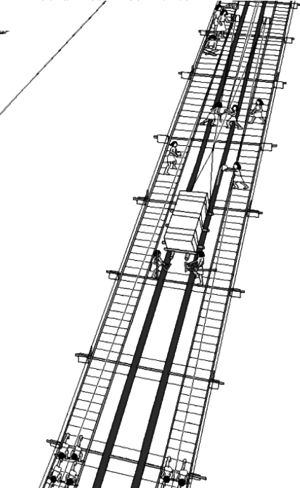Building Egyptian Pyramids: Difference between revisions
From DT Online
mNo edit summary |
mNo edit summary |
||
| (9 intermediate revisions by the same user not shown) | |||
| Line 1: | Line 1: | ||
[[File:All Gizah Pyramids.jpg|right|400px|All Gizah Pyramids|link= | [[File:All Gizah Pyramids.jpg|right|400px|All Gizah Pyramids|link=http://en.wikipedia.org/wiki/Egyptian_pyramids]] | ||
Around 4500 years ago ''(i.e. 2500 BC)'' the ancient Egyptians started building [ | Around 4500 years ago ''(i.e. 2500 BC)'' the ancient Egyptians started building [http://en.wikipedia.org/wiki/Egyptian_pyramids '''Pyramids'''] as tombs for their [http://en.wikipedia.org/wiki/Pharaoh '''Pharaohs'''] without the aid of the kind of machinery we take for granted today. | ||
They are solid and are made from massive blocks of [ | They are solid and are made from massive blocks of [http://en.wikipedia.org/wiki/Sandstone '''sandstone'''], [http://en.wikipedia.org/wiki/Limestone '''limestone'''] or [http://en.wikipedia.org/wiki/Granite '''granite'''] each weighing around 2½ tonnes. It is thought that the blocks were cut from local quarries using wedges and other simple hand tools made from [http://en.wikipedia.org/wiki/Copper '''Copper'''] or [http://en.wikipedia.org/wiki/Bronze '''Bronze''']. After cutting, they were loaded into barges and floated along the [http://en.wikipedia.org/wiki/Nile '''Nile'''] until they were close to the building site. They were then dragged on '''[[Ancient Egyptian Stone Sled|Sleds]]''' to their final position. | ||
The | The '''[[Ancient Egyptian Stone Sled|Sleds]]''' were dragged over planks by teams of workers. Water ''(or milk)'' could have been poured under the '''Sled''' runners to reduce friction. The workers were mainly farmers who thought it an honour to do this work for their pharaoh ''(and workers who died seemed to have been given a proper burial)'' - or perhaps it was a form of tax. Most of the work took place between July and October when the Nile flooded their land so they would have been available for such work. | ||
It has been calculated that each pyramid took 20 years to build and, over the next 1000 years, many of these huge structures were created. Early pyramids were built as a series of steps | It has been calculated that each pyramid took 20 years to build and, over the next 1000 years, many of these huge structures were created. Early pyramids were built as a series of steps which were faced with polished limestone to create a smooth white surface and the tops even given a metalic covering of [http://en.wikipedia.org/wiki/Electrum '''Electrum'''] ''(a naturally occuring alloy of gold and silver)'' such that they would reflect the sun's rays as it rises behind the pyramid. Exactly [http://en.wikipedia.org/wiki/Egyptian_pyramid_construction_techniques how they were built] remains a mystery but theories include: | ||
[[File:PyramidRamps.png|right|300px|Using ramps and sleds to raise pyramid stones|link= | [[File:PyramidRamps.png|right|300px|Using ramps and sleds to raise pyramid stones|link=http://en.wikipedia.org/wiki/Egyptian_pyramid_construction_techniques]] | ||
* Using | * Using '''[[Basic Machines|Ramps]]''' along which the stones were dragged on sledges: | ||
** a long straight ramp would have been very long indeed but no trace remains | ** a long straight ramp would have been very long indeed but no trace remains and this casts doubt on the idea; | ||
** shorter ramps might have been used to take the stones up a step at a time; | ** shorter ramps might have been used to take the stones up a step at a time; | ||
** the pyramid itself could have been used to support ramps either which zig-zagged up a side or wrapped around the pyramid as it was built | ** the pyramid itself could have been used to support ramps either which zig-zagged up a side or wrapped around the pyramid as it was built; | ||
** there is some evidence that internal ramps were also used. | ** there is some evidence that internal ramps were also used. | ||
[[File:PyramidLevers.png|right|300px|Using levers to raise pyramid stones|link=http://en.wikipedia.org/wiki/Egyptian_pyramid_construction_techniques]] | |||
* Using '''[[Class 1 Lever|Levers]]''' to lift the stones up a step at a time: | * Using '''[[Class 1 Lever|Levers]]''' to lift the stones up a step at a time: | ||
** levers were well known and the '''[[Shaduf]]''' ''(or Shadoof)'' was commonly used to raise water for irrigation | ** levers were well known and the '''[[Egyptian Shaduf|Shaduf]]''' ''(or Shadoof)'' was commonly used to raise water for irrigation; | ||
** levers could be used to raise a stone a little at a time and then planks of wood or stones laid under until the height of a step was reached | ** levers could be used to raise a stone a little at a time and then planks of wood or stones laid under until the height of a step was reached; | ||
** the top one third of the pyramids contains only about 4% of the total amount of stone used so it may be that levers were used in combination with ramps to complete the top sections. | ** the top one third of the pyramids contains only about 4% of the total amount of stone used so it may be that levers were used in combination with ramps to complete the top sections. | ||
* Casting the stones in place: | [[File:LöhnerRopeRoll.png|right|300px|Using Rope Rolls to raise pyramid stones|link=http://www.cheops-pyramide.ch/pyramid-building.html]] | ||
** it has been suggested that blocks of the pyramid are not carved stone, but are mostly a form of limestone concrete that were ‘cast’ as with modern [ | * Using a '''‘Rope Roll’''': | ||
** limestone was crushed and mixed with water and lime to make a soft clay like material which was then carried up to be packed into re-usable wooden moulds which were set in place on the pyramid | ** [http://www.cheops-pyramide.ch/pyramid-building.html '''Franz Löhner'''] makes a very strong case for suggesting that the stones were pulled up wooden tracks laid up the sides of the pyramids; | ||
** short ‘Rope Rolls’ ''(a stubby wood axle made smooth by wrapping in copper)'' are mounted in the stonework face as building progresses; | |||
** stones are mounted on sleds which are hauled up the tracks by ropes on either side which are wrapped around the ‘Rope Rolls’ ''(this works in much the same way as a simple '''[[Basic Machines|Pulley]]''' although pulleys themselves were not known at this time)''. | |||
* '''Casting''' the stones in place: | |||
** it has been suggested that blocks of the pyramid are not carved stone, but are mostly a form of limestone concrete that were ‘cast’ as with modern [http://en.wikipedia.org/wiki/Concrete '''Concrete''']; | |||
** limestone was crushed and mixed with water and lime to make a soft clay like material which was then carried up to be packed into re-usable wooden moulds which were set in place on the pyramid; | |||
** there is microscopic evidence of mineral compounds and air bubbles in some pyramid stones that do not occur in natural limestone but the theory is currently far from being accepted even as a remote possibility. | ** there is microscopic evidence of mineral compounds and air bubbles in some pyramid stones that do not occur in natural limestone but the theory is currently far from being accepted even as a remote possibility. | ||
---- | ---- | ||
<span style="color: blue">'''Activity:''' | <span style="color: blue">'''Activity:''' | ||
How would you raise the heavy stones up the Pyramids? | How would you raise the heavy stones up the Pyramids?</span> | ||
* Build a model '''[[Sled]]''' and load it with a 1kg mass then use a Newton meter to pull it up card slopes set at different angles ''(you may wish to glue lengths of stripwood under the card to stiffen it)'': how much difference does the slope angle make to the force needed to pull the sled? What do think would be the best angle for a ramp which pyramid builders could use and why? | * <span style="color: blue">Build a model '''[[Ancient Egyptian Stone Sled|Sled]]''' and load it with a 1kg mass then use a Newton meter to pull it up card slopes set at different angles ''(you may wish to glue lengths of stripwood under the card to stiffen it)'': how much difference does the slope angle make to the force needed to pull the sled? What do think would be the best angle for a ramp which pyramid builders could use and why?</span> | ||
* Glue stripwood across a reinforced card ramp set to your chosen angle, fill the gaps in between with soft sand then try again. What difference does it make if you wet the sand or pour soapy water over the wood strips? | * <span style="color: blue">Glue stripwood across a reinforced card ramp set to your chosen angle, fill the gaps in between with soft sand then try again. What difference does it make if you wet the sand or pour soapy water over the wood strips?</span> | ||
</span> | * <span style="color: blue">Build a model '''[[Egyptian Shaduf|Shaduf]]''' and use it to lift a 1kg mass: how does the '''[[Egyptian Shaduf|Shaduf]]''' make it easier to lift the mass? Where do you have to apply the lifting force and how might this limit the height to which pyramid stones could have been lifted in this way? </span> | ||
* Build a model '''[[Shaduf]]''' and use it to lift a 1kg mass: how does the '''Shaduf''' make it easier to lift the mass? Where do you have to apply the lifting force and how might this limit the height to which pyramid stones could have been lifted in this way? | |||
---- | ---- | ||
Latest revision as of 09:15, 1 March 2017
Around 4500 years ago (i.e. 2500 BC) the ancient Egyptians started building Pyramids as tombs for their Pharaohs without the aid of the kind of machinery we take for granted today.
They are solid and are made from massive blocks of sandstone, limestone or granite each weighing around 2½ tonnes. It is thought that the blocks were cut from local quarries using wedges and other simple hand tools made from Copper or Bronze. After cutting, they were loaded into barges and floated along the Nile until they were close to the building site. They were then dragged on Sleds to their final position.
The Sleds were dragged over planks by teams of workers. Water (or milk) could have been poured under the Sled runners to reduce friction. The workers were mainly farmers who thought it an honour to do this work for their pharaoh (and workers who died seemed to have been given a proper burial) - or perhaps it was a form of tax. Most of the work took place between July and October when the Nile flooded their land so they would have been available for such work.
It has been calculated that each pyramid took 20 years to build and, over the next 1000 years, many of these huge structures were created. Early pyramids were built as a series of steps which were faced with polished limestone to create a smooth white surface and the tops even given a metalic covering of Electrum (a naturally occuring alloy of gold and silver) such that they would reflect the sun's rays as it rises behind the pyramid. Exactly how they were built remains a mystery but theories include:
- Using Ramps along which the stones were dragged on sledges:
- a long straight ramp would have been very long indeed but no trace remains and this casts doubt on the idea;
- shorter ramps might have been used to take the stones up a step at a time;
- the pyramid itself could have been used to support ramps either which zig-zagged up a side or wrapped around the pyramid as it was built;
- there is some evidence that internal ramps were also used.
- Using Levers to lift the stones up a step at a time:
- levers were well known and the Shaduf (or Shadoof) was commonly used to raise water for irrigation;
- levers could be used to raise a stone a little at a time and then planks of wood or stones laid under until the height of a step was reached;
- the top one third of the pyramids contains only about 4% of the total amount of stone used so it may be that levers were used in combination with ramps to complete the top sections.
- Using a ‘Rope Roll’:
- Franz Löhner makes a very strong case for suggesting that the stones were pulled up wooden tracks laid up the sides of the pyramids;
- short ‘Rope Rolls’ (a stubby wood axle made smooth by wrapping in copper) are mounted in the stonework face as building progresses;
- stones are mounted on sleds which are hauled up the tracks by ropes on either side which are wrapped around the ‘Rope Rolls’ (this works in much the same way as a simple Pulley although pulleys themselves were not known at this time).
- Casting the stones in place:
- it has been suggested that blocks of the pyramid are not carved stone, but are mostly a form of limestone concrete that were ‘cast’ as with modern Concrete;
- limestone was crushed and mixed with water and lime to make a soft clay like material which was then carried up to be packed into re-usable wooden moulds which were set in place on the pyramid;
- there is microscopic evidence of mineral compounds and air bubbles in some pyramid stones that do not occur in natural limestone but the theory is currently far from being accepted even as a remote possibility.
Activity: How would you raise the heavy stones up the Pyramids?
- Build a model Sled and load it with a 1kg mass then use a Newton meter to pull it up card slopes set at different angles (you may wish to glue lengths of stripwood under the card to stiffen it): how much difference does the slope angle make to the force needed to pull the sled? What do think would be the best angle for a ramp which pyramid builders could use and why?
- Glue stripwood across a reinforced card ramp set to your chosen angle, fill the gaps in between with soft sand then try again. What difference does it make if you wet the sand or pour soapy water over the wood strips?
- Build a model Shaduf and use it to lift a 1kg mass: how does the Shaduf make it easier to lift the mass? Where do you have to apply the lifting force and how might this limit the height to which pyramid stones could have been lifted in this way?
- Structures and Frames can also be modelled using the Construction Kits listed in the Truss Bridges and Looking at Bridges articles.
Safety Point! Take great care with hot glue guns and all hot-melt glues. The melted glue can stick to the skin and cause severe burns.
 |
 |
 |
 |
 |
 |
 |
 |
 |
 |
 |
| Junior Hacksaw |
Clamp-on Hobby Vice |
Stripwood |
Balsa Wood |
Medium card coloured |
Thick card coloured |
Cutting Mat |
10mm Squared Paper |
PVA glue |
Glue Gun |
Bamboo Flower Sticks |
Notes:
- Choose metal cutting hacksaw blades - the teeth are small which suits this scale of work and they are safer for young children
- School PVA glue is best for young children because it is non-toxic and washes off : PVA Wood Glue is strongest but must be used with care.
- Try to get natural Flower Sticks or wear gloves because the green stain comes off on hands!



